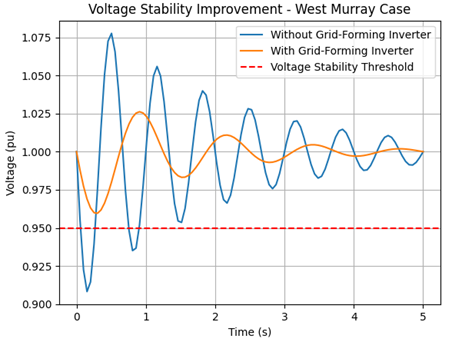Introduction
The National Electricity Market (NEM) of Australia is undergoing a significant transformation due to the increasing integration of renewable energy sources, particularly wind and solar photovoltaic (PV) systems. These technologies are largely non-synchronous and inverter-based, which poses dynamic stability challenges such as reduced system inertia, voltage instability, and frequency regulation difficulties. Dynamic stability refers to the power system's ability to maintain synchronism and quickly return to a stable operating condition after disturbances such as faults or sudden changes in generation or load.
This report explores the implications of high renewable penetration on dynamic stability in the NEM through two real-world case studies: Tasmania's renewable integration and the West Murray region's grid-forming inverter deployment.
Dynamic Stability Challenges in High Renewable Systems
With conventional synchronous generators being displaced by inverter-based resources, the power system experiences a significant drop in inertia. Inertia is crucial in resisting rapid changes in system frequency. Lower inertia leads to higher rates of change of frequency (RoCoF), making the system more sensitive to disturbances. Additionally, non-synchronous generators provide limited or no-fault current contribution and rely on grid-following controls, which may not react swiftly to grid disturbances.
To address these challenges, technologies such as grid-forming inverters, synthetic inertia, and fast frequency response (FFR) are being deployed. These solutions enhance the capability of renewable generation to support dynamic stability in a low-inertia power system.
Case Study 1: Tasmania's Renewable Integration
Tasmania has a unique renewable mix, with hydroelectric power complemented by growing wind generation. The state is connected to the mainland NEM through the Basslink HVDC interconnector. High levels of wind generation have introduced dynamic stability issues due to reduced synchronous inertia (AEMO, 2014).
To counter these issues, Hydro Tasmania has played a pivotal role by using hydroelectric stations to provide inertia and frequency control services. Operational strategies such as the Frequency Control Ancillary Services (FCAS) market participation and real-time monitoring have been adopted. These efforts have successfully maintained frequency within operational limits even during high wind periods.
Figure 1 illustrates the difference in frequency stability in Tasmania under high and low system inertia scenarios. In the high wind/low inertia condition, frequency drops sharply following a disturbance, reflecting a high RoCoF. This behaviour risks triggering under-frequency load shedding or emergency generator responses. In contrast, when synchronous hydro units are dispatched (providing high inertia), the frequency response is more gradual and recovers quickly. This comparison emphasizes the importance of maintaining sufficient system inertia—provided by hydro generation in this case—to ensure dynamic stability during high renewable penetration periods.
Case Study 2: West Murray Region Grid-Forming Inverters
The West Murray region, spanning parts of Victoria and New South Wales, faced voltage oscillations and instability due to high penetration of solar farms using grid-following inverters. The system strength in this area was insufficient to maintain voltage stability during disturbances, leading AEMO to curtail solar generation to ensure grid stability (AEMO, 2021).
To address this, advanced grid-forming inverters were deployed at selected solar farms. These inverters emulate the behaviour of synchronous machines by providing synthetic inertia and voltage control. The introduction of these technologies significantly improved the damping of voltage oscillations and reduced curtailment events.
Figure 2 compares voltage stability in the West Murray region before and after the deployment of grid-forming inverters. Prior to their installation, voltage following a disturbance exhibited poorly damped oscillations due to weak system strength and reliance on grid-following inverters. After grid-forming inverters were integrated, the voltage profile showed significantly improved damping and quicker stabilization. This highlights how grid-forming inverters, by emulating synchronous machine behaviour, can restore and maintain voltage stability in low-strength grid regions, enabling greater integration of inverter-based renewable resources without compromising grid security.
Conclusion
High renewable penetration in the NEM necessitates new approaches to ensure dynamic stability. Real-world examples from Tasmania and the West Murray region demonstrate that advanced technologies, including hydro-based inertia and grid-forming inverters, are effective in addressing these challenges. Continued investment in dynamic modelling, fast frequency response services, and coordinated planning is vital to support the stability of the evolving power grid.
References:
AEMO (2014). Managing a High Penetration of Renewables: A Tasmanian Case Study. [Online] Available at B47810C12E25473CB81968D5D4218F78.ashx
AEMO (2021). Application of Advanced Grid-Scale Inverters in the NEM. [Online] Available at: application-of-advanced-grid-scale-inverters-in-the-nem.pdf

Tasmania Frequency Stability Comparison
Figure 1. Frequency response in Tasmania following a disturbance comparing low inertia (high wind) and high inertia (hydro support) scenarios, illustrating improved frequency stability with higher system inertia.

Voltage Stability Improvement - West Murray Case
Figure 2. Voltage magnitude response in the West Murray region after a disturbance, showing enhanced voltage stability and faster damping with grid-forming inverters compared to conventional grid-following inverters.
By Robert Boschetti & Loau Al-Bahrani
